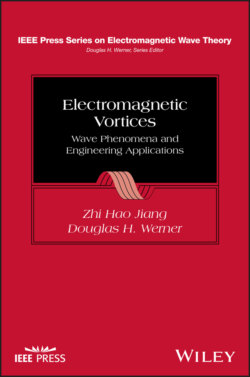Читать книгу Electromagnetic Vortices - Группа авторов - Страница 25
Appendix 1.A OAM Far-field Calculation
ОглавлениеThe aperture field of an OAM‐carrying linearly polarized field with a cylindrically symmetric distribution E(ρ′) can be written as:
(1.A.1)
Table 1.2 Chronicle of milestones regarding OAM.
| Reference | Year | Main contribution |
|---|---|---|
| [1] | 1909 | Theoretically studied angular momentum of circularly polarized waves |
| [2] | 1936 | Experimentally studied the SAM of light and demonstrated that SAM can cause the rotation of a mechanical system |
| [3] | 1992 | Recognized that light beams with an azimuthal phase dependence of ejlϕ carrying OAM |
| [17] | 2004 | Conducted the first experiment on OAM free‐space optical communications |
| [76] | 2006 | Reported the generation of an OAM‐carrying optical vortex in optical fibers |
| [62] | 2007 | Numerically showed that OAM can be used in the radio frequency domain |
| [23] | 2012 | Performed the first experimental test of encoding multiple channels on the same radio frequency through OAM |
| [80] | 2013 | Conducted the first OAM‐MDM experiment suggesting that OAM could provide an additional degree of freedom for data multiplexing in future fiber networks |
| [5] | 2018 | Suggested a potential application that takes advantage of the OAM cone‐shaped pattern in the far‐field |
Figure 1.A.1 Schematic of the generation of OAM aperture field.
where ρ′ and ϕ′ are the radial and azimuthal coordinates in the cylindrical coordinate system; a is the transverse extend of the aperture field of the beam; l is the OAM order. A schematic of the generation of the OAM aperture field is shown in Figure 1.A.1. Typically, the input beam from the feed is a Gaussian‐type beam with a tapered amplitude distribution. The beam waist wg, i.e. the half‐width of the normalized aperture field amplitude at 1/e, is directly related to the OAM antenna aperture diameter D, as shown in Figure 1.A.1. For example, the equivalent beam waist in Ref. [5] was wg = 0.415D for a −12 dB taper illumination. Higher taper illumination would lead to a smaller equivalent beam waist. The role of the OAM antenna (helicoidal reflector in Figure 1.A.1) is to create the desired exit‐aperture amplitude and phase distribution at the infinite exit‐aperture plane. A common model for the aperture field of an OAM antenna is the Laguerre–Gaussian distribution Eq. (1.3).
The equivalent magnetic current density is calculated from [122, eq. 6‐129b]:
(1.A.2)
The radiation integrals can be written as [122, eqs. 6‐125c, 6‐125d]:
(1.A.3)
(1.A.4)
Using the integral identity [5, eq. (5)]:
(1.A.5)
we find the expression of the far‐field integrals:
(1.A.6)
(1.A.7)
where
(1.A.8)
and Jl(⋅) is the lth order Bessel function of the first kind [21]. The expression of the far‐field electric field can be written as [122, eqs. 6‐122b, 6‐122c]:
(1.A.9)
Note the far‐field Eq. (1.A.9) maintains the e−jlϕ phase term.
Special Case 1: Airy Disk. The aperture field of a uniform amplitude and phase distribution is the special case of Eq. (1.A.1), where l = 0 (no OAM) and . Using the integral identity [21, eq. (6.561–5)]:
(1.A.10)
we find I from Eq. (1.A.8) and the far‐field expression from Eq. (1.A.9):
(1.A.11)
Special Case 2: Tapered‐aperture Distribution. A physically meaningful and mathematically simple model for aperture‐like antennas with uniform phase distribution is the two‐parameter (2P) model [22, eq. (16)]:
(1.A.12)
where P and C are parameters that control the shape and amplitude distribution of the circular aperture. In particular, C can be related to the edge taper by ET = 20 log C. A generalized three‐parameter aperture distribution model for elliptical aperture has also been developed in [123]. The far‐field can be evaluated in the closed form [22, eq. (18–20)]:
(1.A.13)
where
(1.A.14)
in which Γ(⋅) is the gamma function [21]. The far‐field of the tapered‐aperture distribution was studied in Section 1.2 and is shown in Figure 1.7a. The OAM tapered‐aperture distribution counterpart was modeled based on Eq. (1.A.12) multiplied by the phase term e−jlϕ:
(1.A.15)
The changes of amplitude pattern shape based on the aperture field of Eq. (1.A.15) from the reactive near‐field toward the far‐field were studied in Section 1.2 and are shown in Figure 1.7b.
Special Case 3: Laguerre–Gaussian beam. The aperture field of the Laguerre–Gaussian beams is given by Eq. (1.3). Using the integral identity [21, eq. (7.421‐4)]
(1.A.16)
we find I from Eq. (1.A.8) and the far‐field expression from Eq. (1.A.9):
(1.A.17)
where Ψ = k0wg sin θ. For the definition of wg refer to the first paragraph of the appendix and Figure 1.A.1. The previous discussion refers to the far‐field where the radiation integral can be found in closed form. The near‐field calculation using the Fresnel–Kirchhoff diffraction integral [24] was carried out numerically in Section 1.2 and the results are shown in Figure 1.7.
